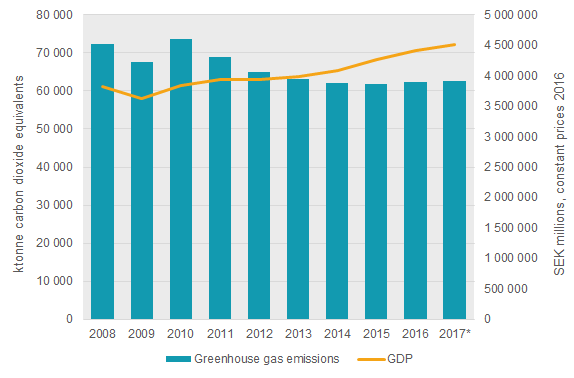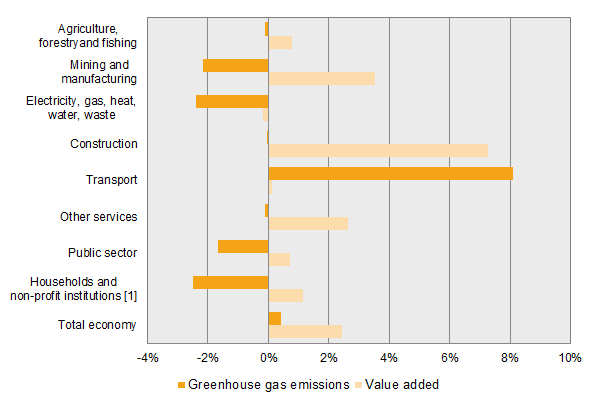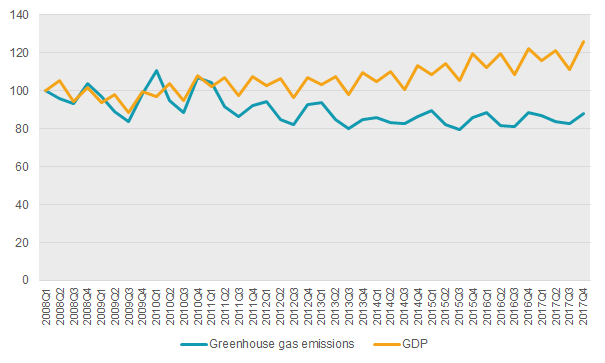Environmental Accounts – Emissions to air Q4 2017 and preliminary statistics for 2017:
Greenhouse gas emissions unchanged in 2017
Statistical news from Statistics Sweden 2018-05-08 9.30
Greenhouse gas emissions by the Swedish economy remained largely unchanged between 2016 and 2017, according to new preliminary statistics for 2017. Emissions by households and the manufacturing industry decreased, while emissions by the transport industry increased. At the same time, GDP growth was 2.4 percent.
Preliminary statistics for 2017 on emissions by industry are now available. Preliminary statistics are the sum of the quarterly statistics in 2017, where the fourth quarter is now ready.
In 2017, greenhouse gas emissions by the Swedish economy amounted to 62.6 million tonnes of carbon dioxide equivalents. The emission level remains largely unchanged from the previous year. In 2014–2017, emissions by the Swedish economy remained largely unchanged. At the same time, Sweden’s economy is growing. In 2017, GDP rose by 2.4 percent compared with the previous year, and by 10.5 percent compared with 2014.
Thousand tonnes of carbon dioxide equivalents and SEK millions, constant prices 2016 (summed quarters)
*2017 preliminary. Source: Statistics Sweden
Emissions by households, mainly from passenger cars, have decreased in recent years, and also in 2017. In 2017, emissions decreased by 2.5 percent compared with the previous year. Greenhouse gas emissions by mining and manufacturing decreased by 2.2 percent between 2016 and 2017. Steel and metal manufacturing, refineries and manufacturing of chemicals and pharmaceuticals were the industries that contributed the most to this decrease. In the same period, economic growth in the mining and manufacturing industry was 3.5 percent. Emissions by electricity, gas and heat decreased by 2.4 percent.
The decrease in greenhouse gas emissions by some aggregated industries is balanced by increased emission levels in other industries. The transport industry in particular has increased its greenhouse emissions by 8 percent in 2017. This is mainly due to increased emissions by the shipping industry.

[1] Only non-profit institutions provide value added.
Source: Statistics Sweden
In the fourth quarter of 2017, greenhouse gas emissions by the Swedish economy and households amounted to 16.1 million tonnes of carbon dioxide equivalents. This is a decrease of 0.5 percent compared with the same quarter in 2016. Compared with 2016, GDP increased by 2.9 percent in the fourth quarter.
Index 2008Q1=100

Source: Statistics Sweden
Revisions
Since the previous publication on 2018-01-31, a number of revisions have been made:
- Updated annual statistics that affect all industries and quarters. For example, emissions have been reallocated regarding working machines and heating of premises, which affects the quarterly statistics.
- Updates in Q1 2017-Q3 2017 regarding process-related emissions.
- Other revisions include minor updates in Quarterly fuel statistics and Monthly fuel statistics 2017.
More information (in Swedish) on the revisions is available at the Environmental Accounts’ product page under Documentation.
Developments in different industries
The connection between emissions of greenhouse gases and industry’s contribution to the Swedish economy varies between industries due to the different types of activities in each industry. Some industries are emissions-intensive, and increased production means higher emissions, while other industries may increase value added without any significant increase in emissions levels.
Thousands tonnes of carbon dioxide equivalents and constant prices, reference year 2016, SEK millions
| Sector | Greenhouse gas emissions | Value added | |||||
|---|---|---|---|---|---|---|---|
| 2017 | Change compared with 2016 | 2017 | Change compared with 2016 | ||||
| Agriculture, forestry and fishing | 9 064 | ‑10 | ‑0.1% | 50 992 | 402 | 0.8% | |
| Mining and manufacturing | 15 583 | ‑344 | ‑2.2% | 633 648 | 21 564 | 3.5% | |
| Electricity, gas, heat, water, waste | 8 398 | ‑207 | ‑2.4% | 110 757 | ‑197 | ‑0.2% | |
| Construction | 1 884 | ‑1 | ‑0.1% | 249 604 | 16 930 | 7.3% | |
| Transport | 14 407 | 1 079 | 8.1% | 165 319 | 209 | 0.1% | |
| Other services | 3 251 | ‑4 | ‑0.1% | 1 934 334 | 49 728 | 2.6% | |
| Public sector | 683 | ‑12 | ‑1.7% | 791 566 | 5 552 | 0.7% | |
| Households and non-profit institutions [1] | 9 328 | ‑238 | ‑2.5% | 52 823 | 594 | 1.1% | |
| Total economy | 62 598 | 265 | 0.4% | 3 989 043 | 94 782 | 2.4% | |
[1] Only non-profit institutions provide value added.
Agriculture, forestry and fishing
Agriculture, forestry and fishing accounted for 14 percent of total greenhouse gas emissions. Most greenhouse gases emitted in this sector (about 90 percent) come from agriculture. The preliminary greenhouse gas emissions in 2017 remain largely unchanged compared with 2016. Value added in the whole sector increased by 1 percent in 2017 compared with 2016.
Mining and manufacturing
Emissions by the mining and manufacturing sector account for 25 percent of all emissions by the Swedish economy and households. Emissions decreased by 2 percent, according to the preliminary statistics for 2017. Steel, metal, chemicals production, refineries and cement production are the industries that contribute the most to greenhouse gas emissions. In the period, value added increased by 3.5 percent.
Electricity, gas, heat, water and waste
Greenhouse gas emissions in this sector annually account for 13 percent of total emissions of greenhouse gases by the Swedish economy and households. Most emissions of greenhouse gases come from electricity and heat production. According to the preliminary statistics, 2017 emissions levels are 2.4 percent lower than in 2016 and value added remain largely unchanged.
Construction
Greenhouse gas emissions in this sector account for 3 percent of total greenhouse gas emissions in the Swedish economy and households. Emissions arise mainly in the transport, machinery and industry vehicles sector. In 2017, preliminary model-estimated greenhouse gas emissions remained largely unchanged compared with 2016, while value added increased by 7 percent.
Transport
Greenhouse gas emissions in the transport sector account for 23 percent of total emissions in the Swedish economy and households. Emissions increased by 8.1 percent, according to the 2017 preliminary statistics, compared with the previous year. Emissions are mainly generated by shipping, but also by aviation. Value added remained unchanged in 2017 compared with 2016.
Other services
Greenhouse gas emissions in the transport sector account for 5 percent of total emissions in the Swedish economy and households. Emissions in these industries are relatively small compared with value added, and are mainly due to road transports. In 2017, emissions remained largely unchanged, while value added increased by almost 3 percent compared with 2016.
Public sector
Greenhouse gas emissions in the public sector (central government, county and municipality) account for about 1 percent of total emissions in the Swedish economy and households. Emissions arise mainly in working machinery, road transports and military activities. Emissions increased by 2 percent compared with 2016, according to the preliminary statistics. Value added increased by 1 percent in the same period.
Households and non-profit institutions
Greenhouse gas emissions by households and non-profit institutions account for 15 percent of total emissions in the Swedish economy and households. Emissions arise mainly in households’ car transport. Greenhouse gas emissions decreased by 2.5 percent compared with 2016, according to the 2017 preliminary statistics. This is due to increased use of biodiesel and reduced use of gasoline and fossil diesel. Only non-profit institutions contribute with a small value added. Value added increased by 1 percent compared with 2016.
Fourth quarter 2017. Greenhouse gas emissions and value added, fourth quarter 2017, by aggregated industry NACE Rev.2
Thousands tonnes of carbon dioxide equivalents and constant prices, reference year 2016, SEK millions
| Quarter | Greenhouse gas emissions | Value added | |||||
|---|---|---|---|---|---|---|---|
| 2017Q4 | Change compared with 2016Q4 | 2017Q4 | Change compared with 2016Q4 | ||||
| Agriculture, forestry and fishing | 2 277 | ‑26 | ‑1.1% | 11 059 | 250 | 2.3% | |
| Mining and manufacturing | 4 062 | ‑103 | ‑2.5% | 163 391 | 8 505 | 5.5% | |
| Electricity, gas, heat, water, waste | 2 376 | ‑48 | ‑2.0% | 29 170 | 584 | 2.0% | |
| Construction | 478 | ‑19 | ‑3.7% | 63 417 | 4 039 | 6.8% | |
| Transport | 3 638 | 190 | 5.5% | 44 792 | 443 | 1.0% | |
| Other services | 825 | ‑12 | ‑1.4% | 515 884 | 11 560 | 2.3% | |
| Public sector | 171 | ‑6 | ‑3.5% | 209 809 | 2 950 | 1.4% | |
| Households and non-profit institutions [1] | 2 301 | ‑64 | ‑2.7% | 13 748 | 119 | 0.9% | |
| Total economy | 16 129 | ‑88 | ‑0.5% | 1 051 270 | 28 450 | 2.8% | |
[1] Only non-profit institutions provide value added.
Definitions and explanations
The Environmental Accounts are compiled within the framework of the System of Environmental and Economic Accounts (SEEA) and present national environmental statistics and economic statistics in the same framework, using NACE industry classification. Environmentally-related statistics connected to the system of national accounts enable an analysis of the Swedish economy and the impact that each industry has on the environment.
Emissions to air according environmental accounts is based on a production perspective and defined by the nationality of economic actors. Direct emissions from Swedish economic actors are included, regardless of where in the world emissions occur. This is called the residence principle and includes three parts:
- Emissions within the Swedish territory
- Deduct emissions by aviation, navigation and land transport from foreign economic actors in Sweden
- Add emissions by aviation, navigation and land transport from Swedish economic actors abroad
As an approximation, the environmental accounts residence adjustment currently includes emissions from international bunkers, that is, international aviation and navigation arriving and refuelling at Swedish airports and harbours. A simplified assumption is thus made that emissions resulting from foreign land transports in Sweden are equal to emissions resulting from Swedish land transports abroad and that emissions related to what Swedish ships and planes bunker abroad are equal to emissions related to what foreign ships and planes bunker in Sweden.
Indirect emissions resulting from imports and other consumption of goods and services are not included. Emissions and removals resulting from land use and land use change (LULUCF) and carbon capture and storage (CCS) are not included.
Annual Environmental Accounts on emissions to air by industry currently has a production time of 15 months. There is a demand for more up-to-date statistics on emissions to air of greenhouse gases. To meet this need, Environmental Accounts at Statistics Sweden has developed quarterly statistics on emissions to air by industry, which are also used to produce preliminary annual statistics. These quarterly statistics are also used to produce preliminary data for T-1, and this data is delivered to Eurostat.
Quarterly statistics on all greenhouse gases and a number of air pollutants are available in Sweden’s Statistical Database. Excel spreadsheets are also available for download on Statistics Sweden’s website, and include data and figures on greenhouse gas emissions and emissions intensities by value added and per employee.
The SEEA analytical web tool contains the collected statistics about this area – from production to demand – including statistics on environmental economic steering instruments, economic development and environmental pressure from production and final demand.
Next publishing will be
The next statistical news, on quarterly emissions to air for the first quarter 2018, is scheduled for publication on 2018-08-30 at 09.30.
Statistical Database
More information is available in the Statistical Database
Feel free to use the facts from this statistical news but remember to state Source: Statistics Sweden.
